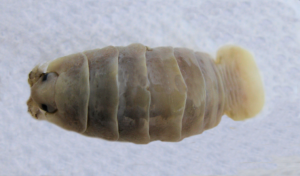Cynothoidae Family of Isopods
Phylogeny: The Cymothoidae Isopods are members of the Cynothoidae Family. They belong to the Phylum Arthropoda, the Class Malacostraca and the Order Isopoda.
Distribution: Cymothoidae Isopods found globally in all temperate and tropical seas. The Cymothoidae Family have three hundred and eighty individual species that have been placed in forty genera. They are found in brackish, freshwater and marine environments. Most are found in shallow water, but a few are bathypelagic.
Morphology: They are anthropods, indicative that they have jointed legs, and similar to terrestrial Pill Bugs, Sow Bugs, and Wood Lice. Isopods have a rigid, segmented exoskeleton, two pairs of antennae, seven limbs, and five respiratory appendages. These Isopods have an unfused pleon of five free segments, compound eyes, and mouth parts that are modified for their parasitic behavior. Most specimens have a slightly twisted body that is believed to occur due to the result of their position relative to their host. Isopods in the Cynothoidae Family are among the largest Isopods, reaching up to 7.5 cm (3.0 inches) in length.
Ecosystem Roles: Cymothoidae Isopods live on the outside of their host (ectoparasitism) primarily consuming the blood of the host. Adults are found primary attached to the gills, mouth, skin, or the base of fins of fish but they also can be found attached to invertebrates. Some are highly host specific, while others will attach to numerous different species. Some are ecologically specific, targeting types of fish based on lifestyle e.g. schooling fish, demersal fish, etc.; others are taxonomically specific, targeting only certain species. These isopods can significantly alter the life of their host by causing traumatic injury, scar tissue build up, reduced ability to flee predation, and secondary infections. As juveniles, Cymothoidae Isopods are free swimming and at this stage of life they are non-selective and will burrow into the skin of many types of fish. Once they become more mature, and find the correct, long term, host, they will attach to the new host and lose their ability to swim. Probably the most unique species in this Family is the Tongue-eating Isopod, Cymothoa exigua. This species attaches to, and consumes, the tongue of its host fish. The Isopod’s body then functions as the fish’s tongue, allowing the fish to survive. Fish that acquire ectoparasites attempt to remove them by jumping out of the water, rubbing against solid objects, and seeking out “cleaning stations” frequented by Cleaner Shrimp, Cleaner Wrasses, and other fish species that eat the parasites attached to the affected fish. In this symbiotic relationship, the affected fish are cleaned of parasites, do not prey on their cleaners, and the cleaners get a fairly easy meal.
Reproduction: Cymothoidae Isopods are protandrous hermaphrodites containing sex organs of both sexes. They all begin life as males and when the number of females in an area drops below a certain level the most mature males transition to females. The females are capable of releasing a pheromone that prevents the males in the vicinity form changing to females. Once they become female, they lose their ability to crawl and are committed for live to their current host. In some species, the females lose their ability to eat, and live off the stored energy that they built up as males.

